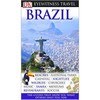Brazilian Ecotourism - Atlantic Forest and Mountain Regions
by Roberto Mourão
The Atlantic Forest ecosystem follows the Brazilian coastline and is the region most visited by Brazilian and foreign tourists. Many of Brazil's major cities are situated there: Rio de Janeiro, Salvador, Curitiba, Natal, Porto Seguro and Recife, many of which also provide access to other ecosystems, such as the Savanna and the Mountain Regions.
The first contact with Brazil of settlers almost five centuries ago, the Atlantic Forest has suffered from an intense process of occupation and consequent destruction as the result of the establishment and development of large cities which accelerated even further the process of degradation, exposing the fauna and flora to serious risks of extinction. Formerly characterised by dense forests rich in vegetable species, and still with vestiges of one of the largest biodiversities of the planet, the Atlantic Forest, with less than 5% of its original vegetation, is the Brazilian ecosystem most threatened by human occupation.
With relief varying from sea level to 2,000 metres above sea level, and responsible for its peculiar climate and temperatures, the Atlantic Forest has rivers and brooks which turn into waterfalls and cataracts and presents mountains and mountain ranges which still have occasional areas of forest with a wealth of flora and fauna. These mountain regions allow countless ecotourism activities and particularly the practice of sports such as walking, camping, canoeing, rafting, climbing and mountaineering.
The city of Rio de Janeiro has the largest urban forest in the world, the Tijuca National Park with an area of 3,300 hectares, on the highest point of which, the Corcovado mountain, there stands one of the city's symbols: the statue of Christ the Redeemer. One of the destinations most visited by tourists who come to Brazil, the Tijuca Forest allows ecotourists to go on walks and observe wildlife. In the Park there are also Pedra da Gávea, with a summit over 800 metres above sea level which may be reached on foot, and Pedra Bonita, with a take-off ramp for hang gliding and parapeting.
In the Atlantic Forest there are several parks and reserves full of lush vegetation despite the poor infrastructure of some, as accommodation is provided generally at hotels and inns on their periphery. These include the Iguaçu National Park, in the State of Paraná; the Aparados da Serra National Park in Rio Grande de Sul; the Itatiaia National Park and the Serra dos Orgãos Park, in Rio de Janeiro State; and the Caparaó National Park and Serra de Canastra, in the State of Minas Gerais.
It is important for amateur and professional speleologists to know that most Brazilian caves are to be found in the Atlantic Forest, in the Savanna or in its transitional area, especially in the States of Bahia, Ceará, Goiás, Mato Grosso, Minas Gerais, Paraná, Pernambuco and São Paulo. In the State of São Paulo alone, in the Alto do Ribeira State Tourist Park (Petar) there are over 200 caves, around 40 of which may be visited by appropriately dressed and equipped persons, accompanied by specialist guides. Permits, guides and clothing and equipment hire are available at specialist agencies near the areas with caves.![]() More on Brazil:
More on Brazil:![]() 2016 Olympics Rio de Janeiro
2016 Olympics Rio de Janeiro![]() 2014 World Cup
2014 World Cup![]() Flag of Brazil
Flag of Brazil![]() Canavieiras - Bahia
Canavieiras - Bahia![]() Camocim - Ceara
Camocim - Ceara![]() Brazilian Portuguese Language
Brazilian Portuguese Language![]() Prawn with Moqueca blinis
Prawn with Moqueca blinis
January 4, 2008
Brazilian Ecotourism - Atlantic Forest and Mountain Regions
Tag
Brazil
0
comments
0
comments
|
|

 Welcome to Travel to Brazil.
Welcome to Travel to Brazil.
